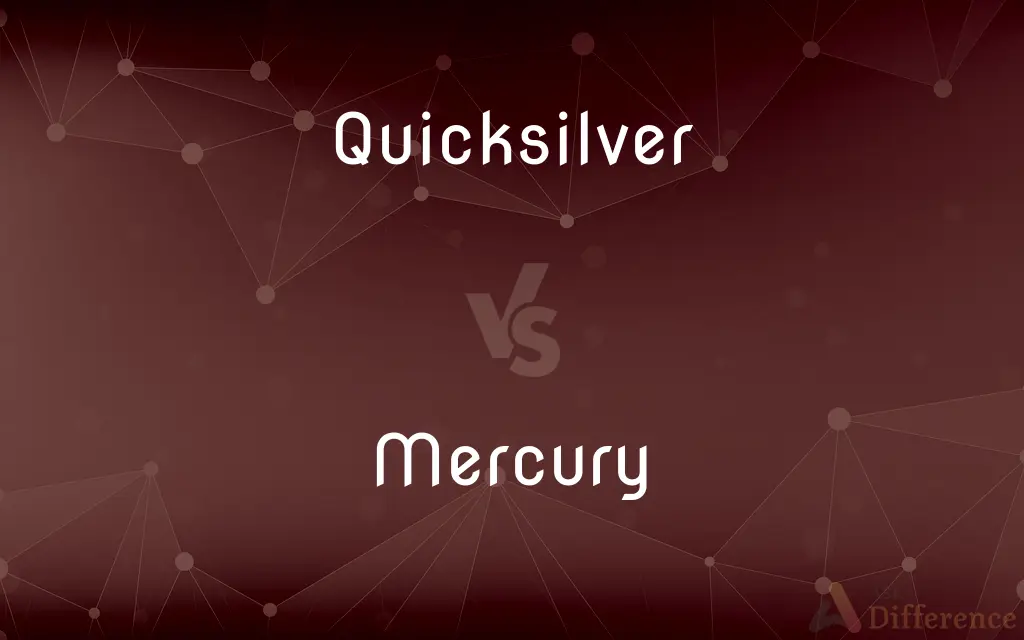Quicksilver vs. Mercury — What's the Difference?
By Urooj Arif & Fiza Rafique — Updated on March 18, 2024
Quicksilver is another name for mercury, a heavy, silvery metal that is liquid at room temperature.

Difference Between Quicksilver and Mercury
Table of Contents
ADVERTISEMENT
Key Differences
Quicksilver, historically known as the liquid metal, is simply an old term for mercury. The name "quicksilver" comes from its liquid form and its quick, fluid motion. Both terms refer to the same chemical element with the symbol Hg and atomic number 80. Mercury, or quicksilver, is unique among metals for being liquid at room temperature, making it distinctive in appearance and physical properties. This characteristic allows it to be used in various applications, including thermometers, barometers, and fluorescent lamps.
While the term "quicksilver" is steeped in historical and alchemical contexts, "mercury" is more commonly used in scientific and industrial settings today. The shift from "quicksilver" to "mercury" reflects a move towards standardized chemical nomenclature.
Both terms, however, carry health and environmental concerns due to mercury's toxicity. It can pose significant health risks if inhaled or ingested, leading to efforts to reduce its use and release into the environment.
Despite these concerns, mercury's unique properties, such as its high density, electrical conductivity, and ability to form amalgams with other metals, continue to make it valuable in various scientific and industrial applications.
Comparison Chart
Name Origin
Comes from its quick, fluid motion and metallic look.
Named after the Roman god, Mercury; symbol Hg from the Greek word hydrargyrum, meaning "liquid silver."
ADVERTISEMENT
Physical State
Liquid metal at room temperature.
The only metal that is liquid at room temperature.
Uses
Historical uses in alchemy and medicine.
Used in thermometers, barometers, dental amalgams, and fluorescent lamps.
Toxicity
Toxic, can cause mercury poisoning if inhaled or ingested.
Known for its environmental and health hazards, especially in the form of methylmercury.
Symbol and Atomic Number
Hg, atomic number 80.
Hg, atomic number 80.
Compare with Definitions
Quicksilver
Used in alchemical texts and experiments.
Alchemists often referred to quicksilver in their quest to transmute base metals into gold.
Mercury
Widely used in scientific instruments and industrial processes.
Mercury is used in thermometers for its stable expansion properties.
Quicksilver
Once used in various medical treatments.
Quicksilver was ingested as a treatment for syphilis in the past.
Mercury
Used in dentistry to create fillings.
Dental amalgams contain mercury, which hardens to form a durable filling material.
Quicksilver
Known for its liquid state and high surface tension.
Quicksilver beads up and scatters when spilled, due to its high surface tension.
Mercury
Conducts electricity, used in switches and relays.
Mercury switches are used in some thermostats and automotive lights.
Quicksilver
Historical uses were often unaware of its toxic effects.
The use of quicksilver in hat making led to the phrase mad as a hatter.
Mercury
Subject of environmental regulations due to its toxicity.
The Minamata Convention aims to protect human health and the environment from mercury emissions.
Quicksilver
In literature, often symbolizes changeability and elusiveness.
Quicksilver's fluid nature made it a metaphor for unpredictability in ancient texts.
Mercury
Forms amalgams with many metals, useful in gold mining.
Mercury is used to extract gold from ore in artisanal and small-scale gold mining.
Quicksilver
Unpredictable; mercurial
"a quicksilver character, cool and willful at one moment, utterly fragile the next" (Sven Birkerts).
Mercury
Roman Mythology A god that served as messenger to the other gods and was himself the god of commerce, travel, and thievery.
Quicksilver
See mercury.
Mercury
The smallest of the planets and the one nearest the sun, having a sidereal period of revolution about the sun of 87.97 days at a mean distance of 57.91 million kilometers (35.98 million miles) and a mean radius of approximately 2,440 kilometers (1,516 miles).
Quicksilver
The metal mercury.
Mercury
Symbol HgA silvery-white poisonous metallic element, liquid at room temperature and used in thermometers, barometers, vapor lamps, and batteries and in the preparation of chemical pesticides. Atomic number 80; atomic weight 200.59; melting point -38.83°C; boiling point 356.62°C; specific gravity 13.546 (at 20°C); valence 1, 2.Also called quicksilver. See Periodic Table.
Quicksilver
(colloquial) An amalgam of mercury and tin applied to the backs of mirrors, quicksilvering.
Mercury
Temperature:The mercury had fallen rapidly by morning.
Quicksilver
Unpredictable, erratic or fickle; mercurial.
Mercury
Any of several weedy plants of the genera Mercurialis and Acalypha.
Quicksilver
To overlay with quicksilver.
Mercury
A metal.
Quicksilver
To treat with quicksilver.
Mercury
A silvery-colored, toxic, metallic chemical element, liquid at room temperature, with atomic number 80 and symbol Hg.
Quicksilver
The metal mercury; - so called from its resemblance to liquid silver.
Mercury
One of the elemental principles formerly thought to be present in all metals.
Quicksilver
A heavy silvery toxic univalent and bivalent metallic element; the only metal that is liquid at ordinary temperatures
Mercury
(with definite article) Ambient pressure or temperature (from the use of mercury in barometers and thermometers).
The mercury there has averaged 37.6°C, 2.3°C above the February norm.
Quicksilver
Liable to sudden unpredictable change;
Erratic behavior
Fickle weather
Mercurial twists of temperament
A quicksilver character, cool and willful at one moment, utterly fragile the next
Mercury
(obsolete) Liveliness, volatility.
Mercury
Any of several types of plant.
Mercury
An annual plant, annual mercury (Mercurialis annua), formerly grown for its medicinal properties; French mercury, herb mercury.
Mercury
Any plant of any species of the genus and the genus Mercurialis.
Mercury
A similar edible plant (Blitum bonus-henricus), otherwise known as English mercury or novern=1.
Mercury
The poison oak or poison ivy.
Mercury
A Latin god of commerce and gain; - treated by the poets as identical with the Greek Hermes, messenger of the gods, conductor of souls to the lower world, and god of eloquence.
Mercury
A metallic element mostly obtained by reduction from cinnabar, one of its ores. It is a heavy, opaque, glistening liquid (commonly called quicksilver), and is used in barometers, thermometers, etc. Specific gravity 13.6. Symbol Hg (Hydrargyrum). Atomic weight 199.8. Mercury has a molecule which consists of only one atom. It was named by the alchemists after the god Mercury, and designated by his symbol,
Mercury
One of the planets of the solar system, being the one nearest the sun, from which its mean distance is about 36,000,000 miles. Its period is 88 days, and its diameter 3,000 miles.
Mercury
A carrier of tidings; a newsboy; a messenger; hence, also, a newspaper.
Mercury
Sprightly or mercurial quality; spirit; mutability; fickleness.
He was so full of mercury that he could not fix long in any friendship, or to any design.
Mercury
A plant (Mercurialis annua), of the Spurge family, the leaves of which are sometimes used for spinach, in Europe.
Mercury
To wash with a preparation of mercury.
Mercury
A heavy silvery toxic univalent and bivalent metallic element; the only metal that is liquid at ordinary temperatures
Mercury
(Roman mythology) messenger of Jupiter and god of commerce; counterpart of Greek Hermes
Mercury
The smallest planet and the nearest to the sun
Mercury
Temperature measured by a mercury thermometer;
The mercury was falling rapidly
Common Curiosities
Why is mercury called quicksilver?
The term "quicksilver" derives from the old English term for the liquid metal, emphasizing its quick, fluid properties.
What are the dangers of mercury exposure?
Mercury exposure can lead to neurological and kidney damage, and is particularly harmful to developing fetuses.
Can mercury be found in everyday products?
Mercury is found in some fluorescent lamps, dental amalgams, and historically in thermometers and barometers.
Is quicksilver still used today?
While the term "quicksilver" is less common, mercury, the substance it refers to, is still used in various applications.
What are the uses of mercury in industry?
Mercury is used in the production of chlorine and caustic soda, and in gold mining to extract gold from ore.
What are amalgams and how do they involve mercury?
Amalgams are alloys containing mercury, used in dental fillings and in extracting precious metals in mining.
How does mercury affect aquatic ecosystems?
Mercury can convert to methylmercury in water, accumulating in fish and posing risks to aquatic life and humans.
How is mercury mined or produced?
Mercury is obtained from the mining of cinnabar, a mercury sulfide mineral, followed by heating and condensing the vapor.
Why is mercury used in thermometers?
Mercury expands consistently with temperature changes, making it ideal for precise measurements.
How is mercury poisoning treated?
Treatment involves removing the source of exposure, supportive care, and in some cases, chelation therapy to bind and remove mercury from the body.
What is the environmental impact of mercury?
Mercury can bioaccumulate in food chains, particularly in fish, posing risks to wildlife and humans.
What are safe levels of mercury exposure?
Safe levels depend on the form of mercury; for methylmercury, the U.S. EPA recommends a maximum of 0.1 micrograms per kilogram of body weight per day.
How can mercury be safely disposed of?
Mercury should be treated as hazardous waste and disposed of according to local environmental regulations.
What international agreements regulate mercury use and emissions?
The Minamata Convention on Mercury aims to protect human health and the environment from mercury emissions.
How is mercury used in traditional medicine?
Historically, mercury was used in various medicines, but its use has declined due to awareness of its toxicity.
Share Your Discovery

Previous Comparison
Deer vs. Antelope
Next Comparison
Woad vs. IndigoAuthor Spotlight
Written by
Urooj ArifUrooj is a skilled content writer at Ask Difference, known for her exceptional ability to simplify complex topics into engaging and informative content. With a passion for research and a flair for clear, concise writing, she consistently delivers articles that resonate with our diverse audience.
Co-written by
Fiza RafiqueFiza Rafique is a skilled content writer at AskDifference.com, where she meticulously refines and enhances written pieces. Drawing from her vast editorial expertise, Fiza ensures clarity, accuracy, and precision in every article. Passionate about language, she continually seeks to elevate the quality of content for readers worldwide.














































